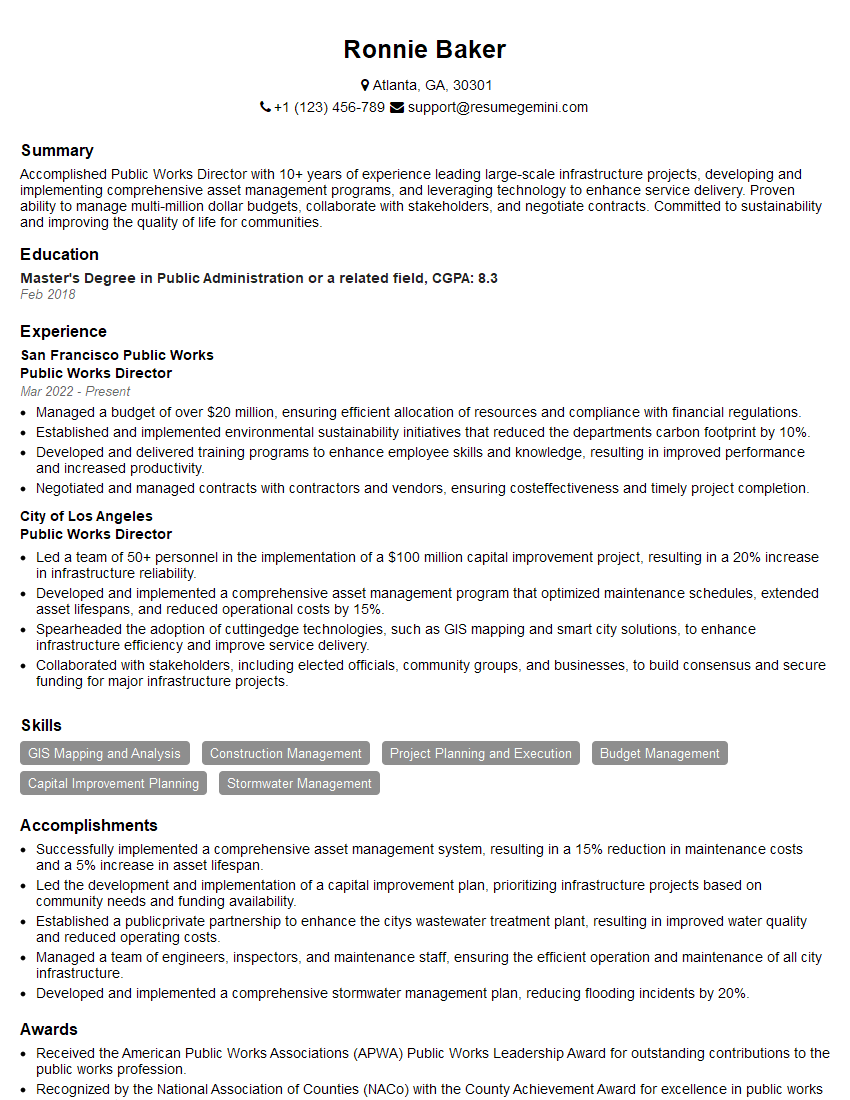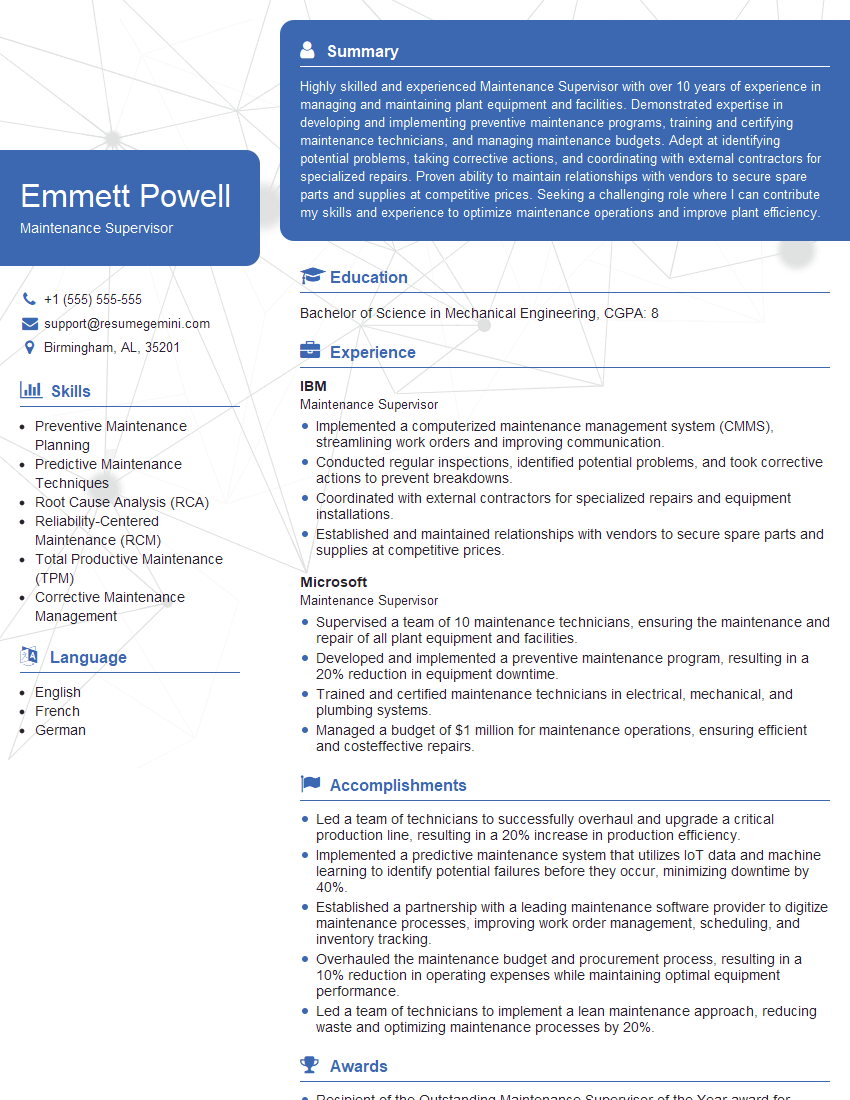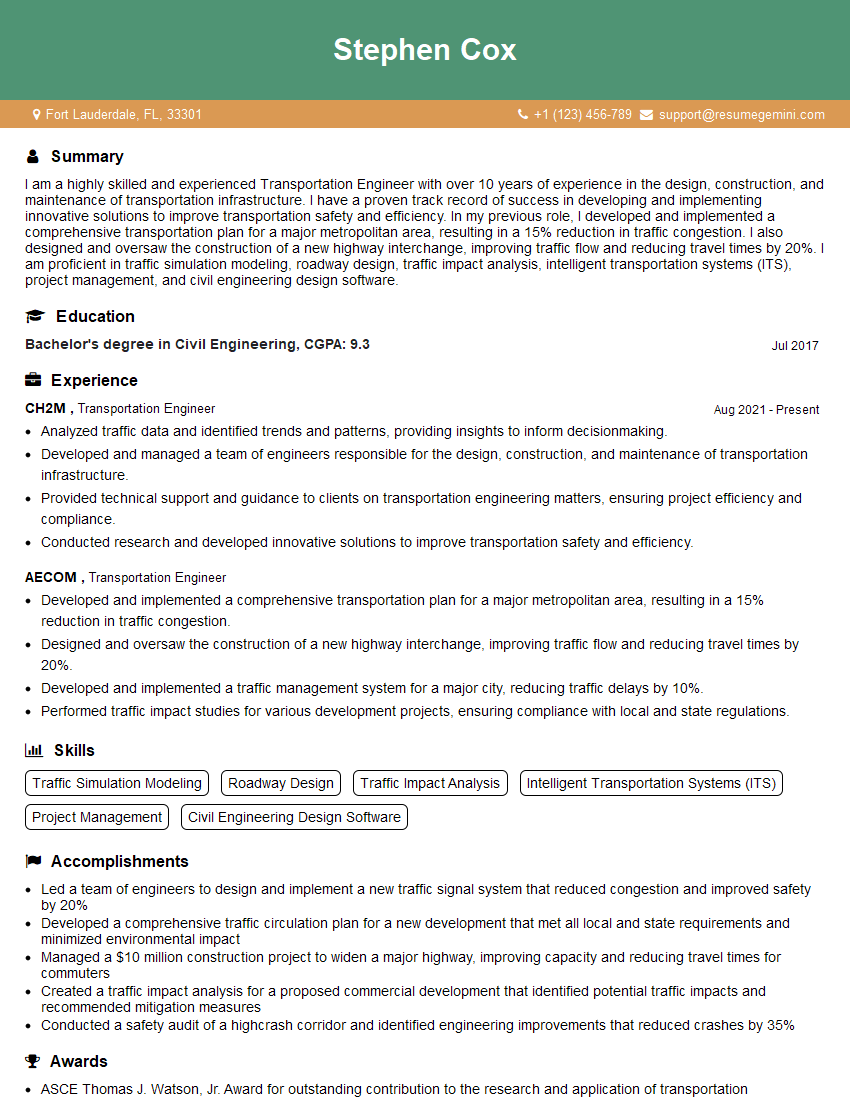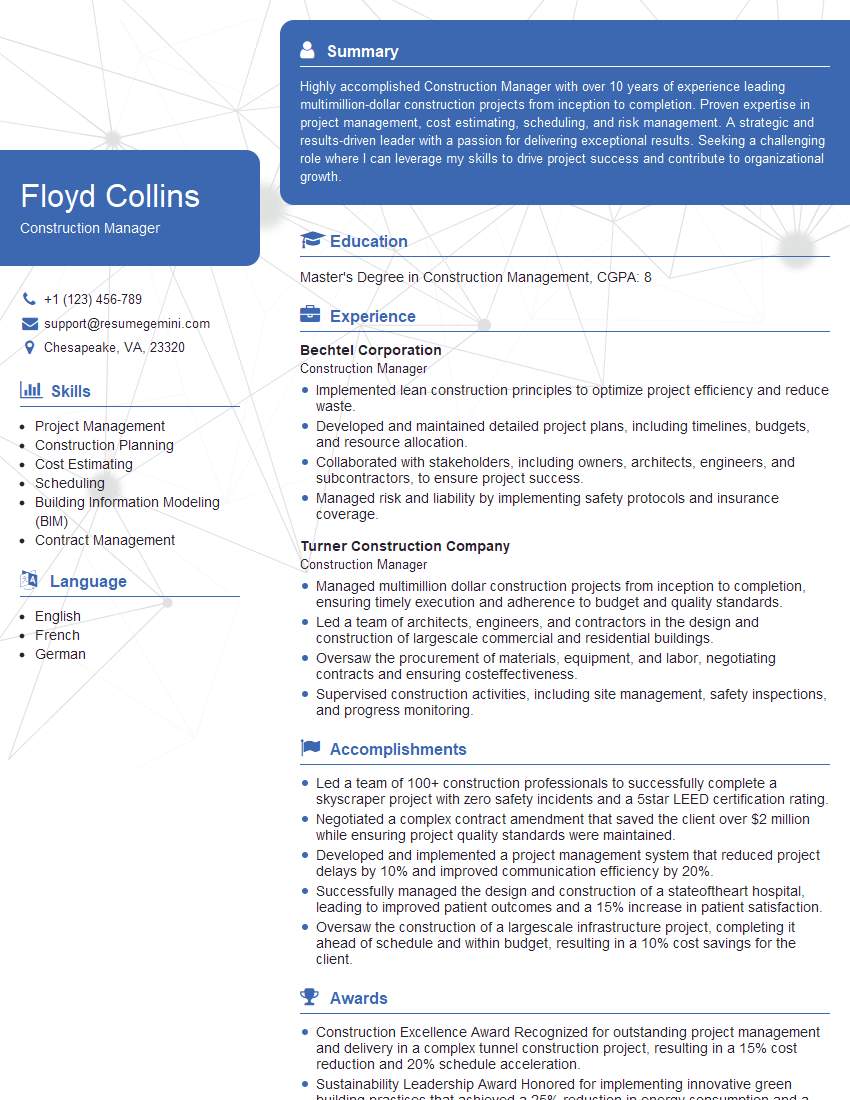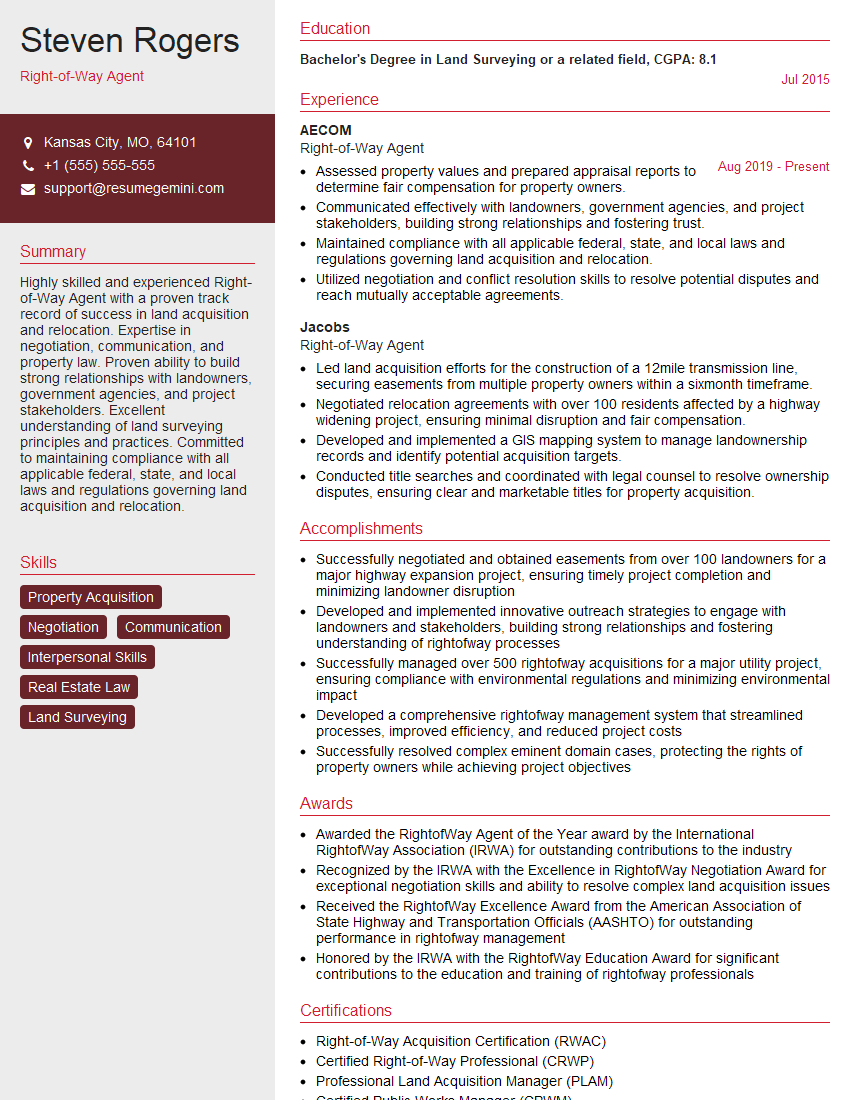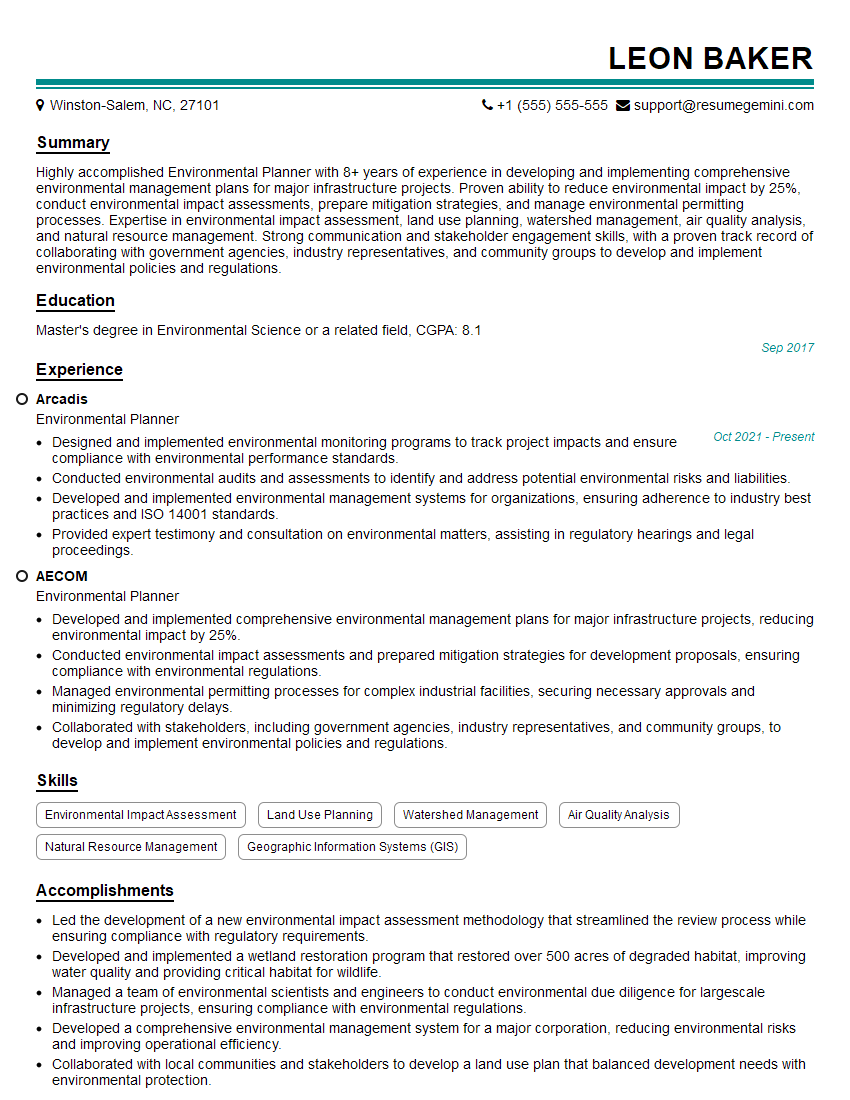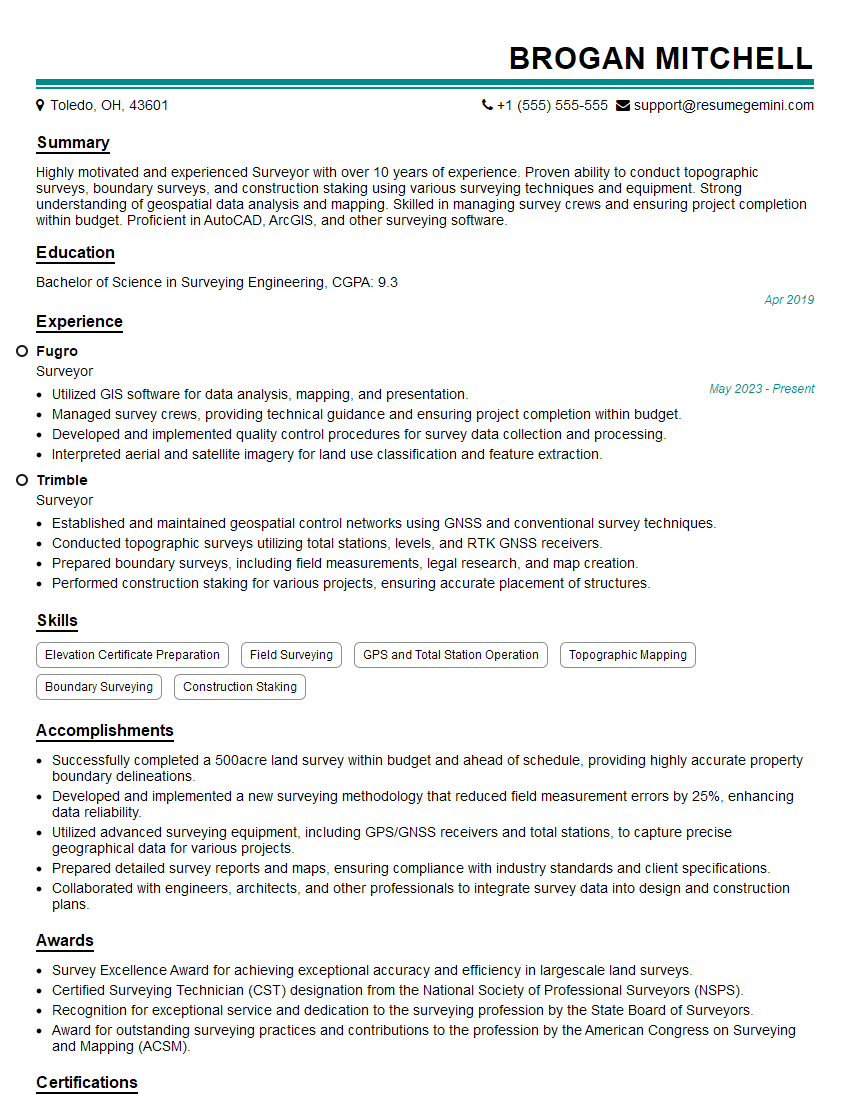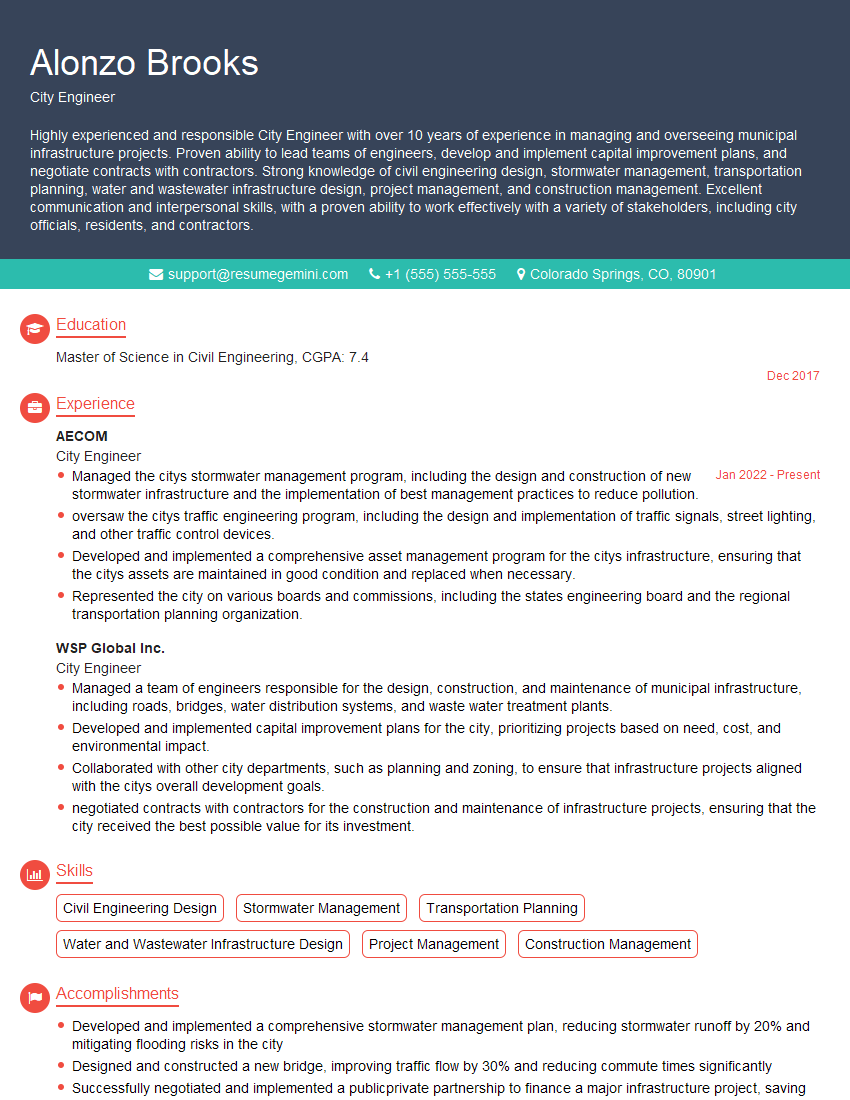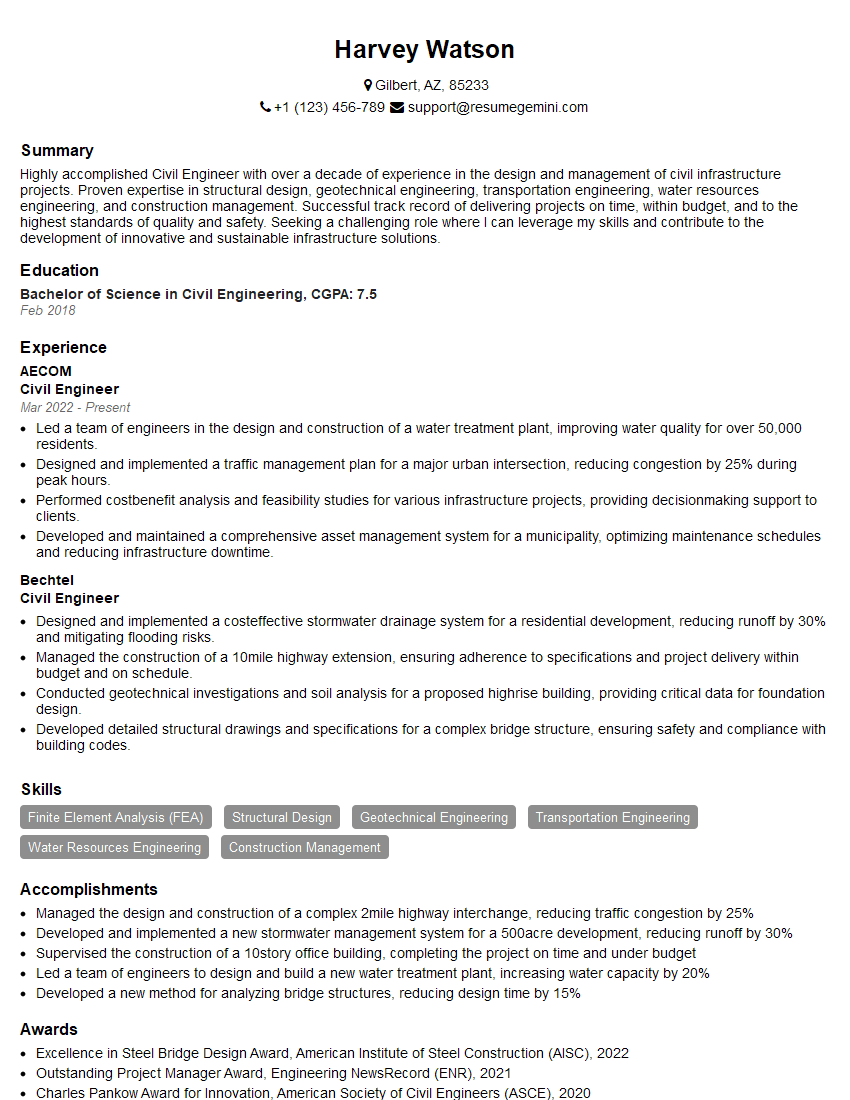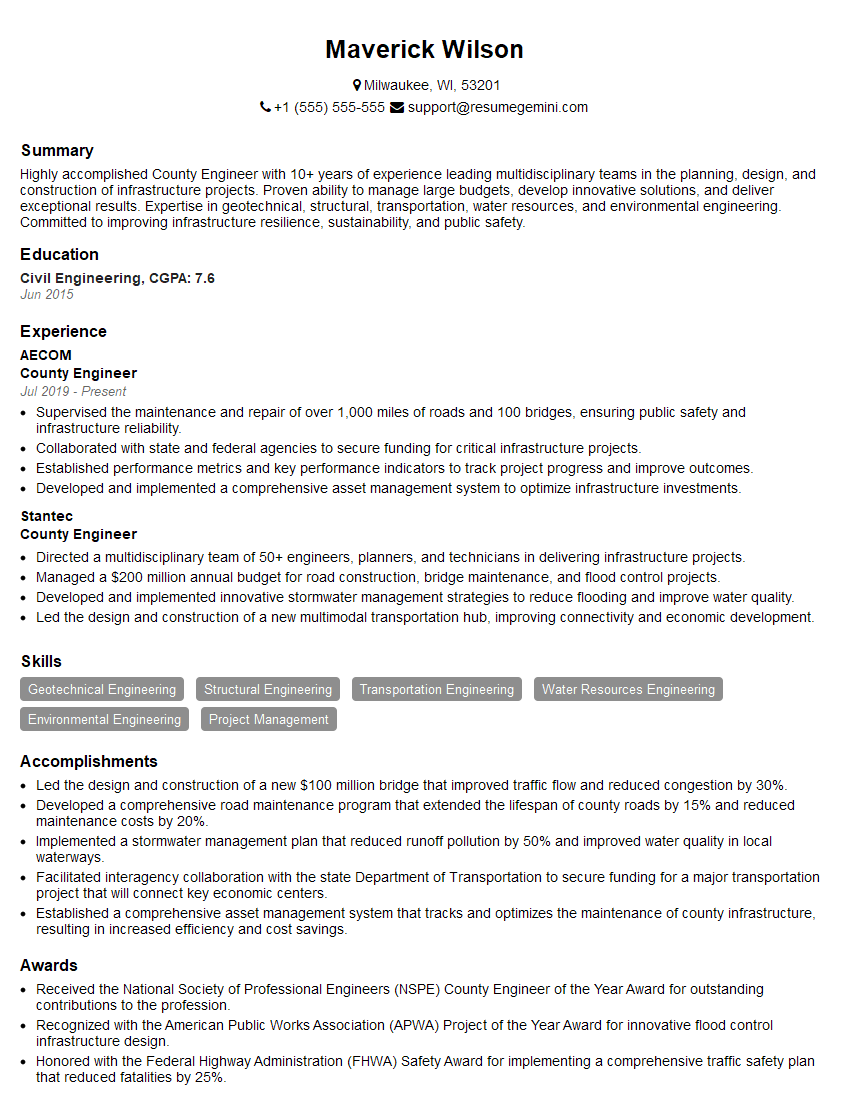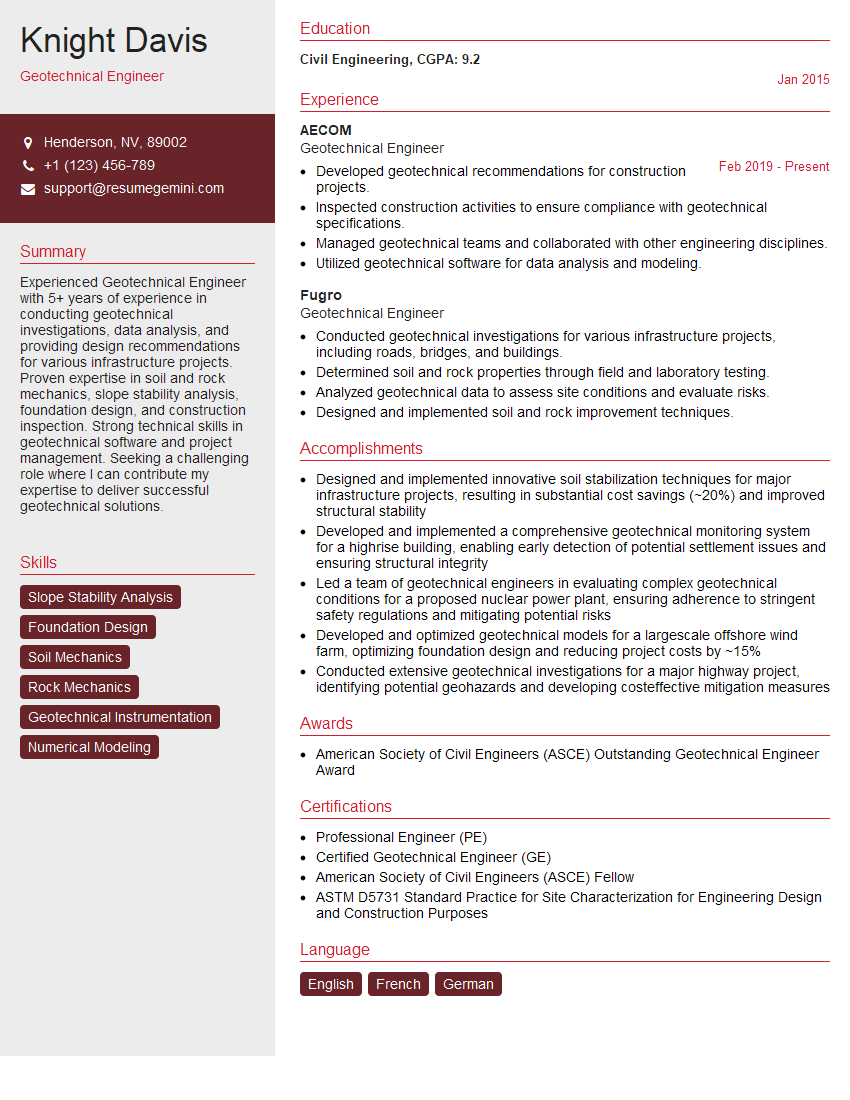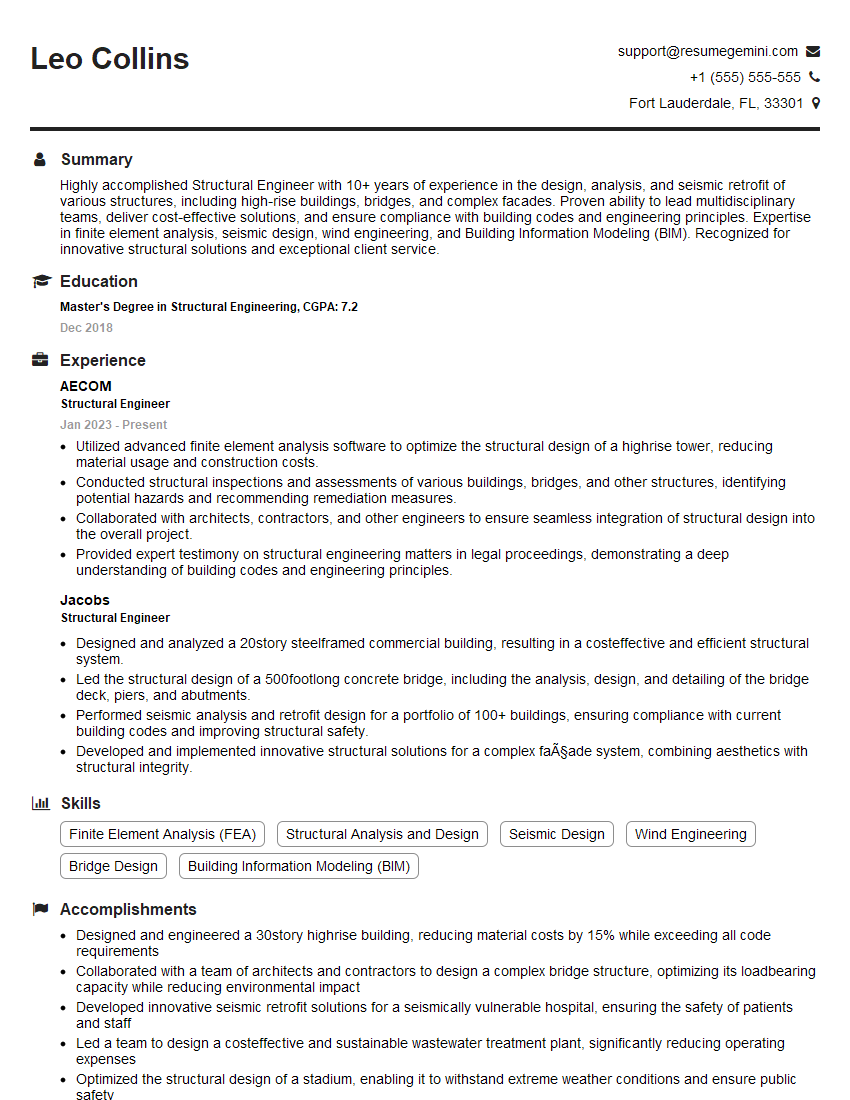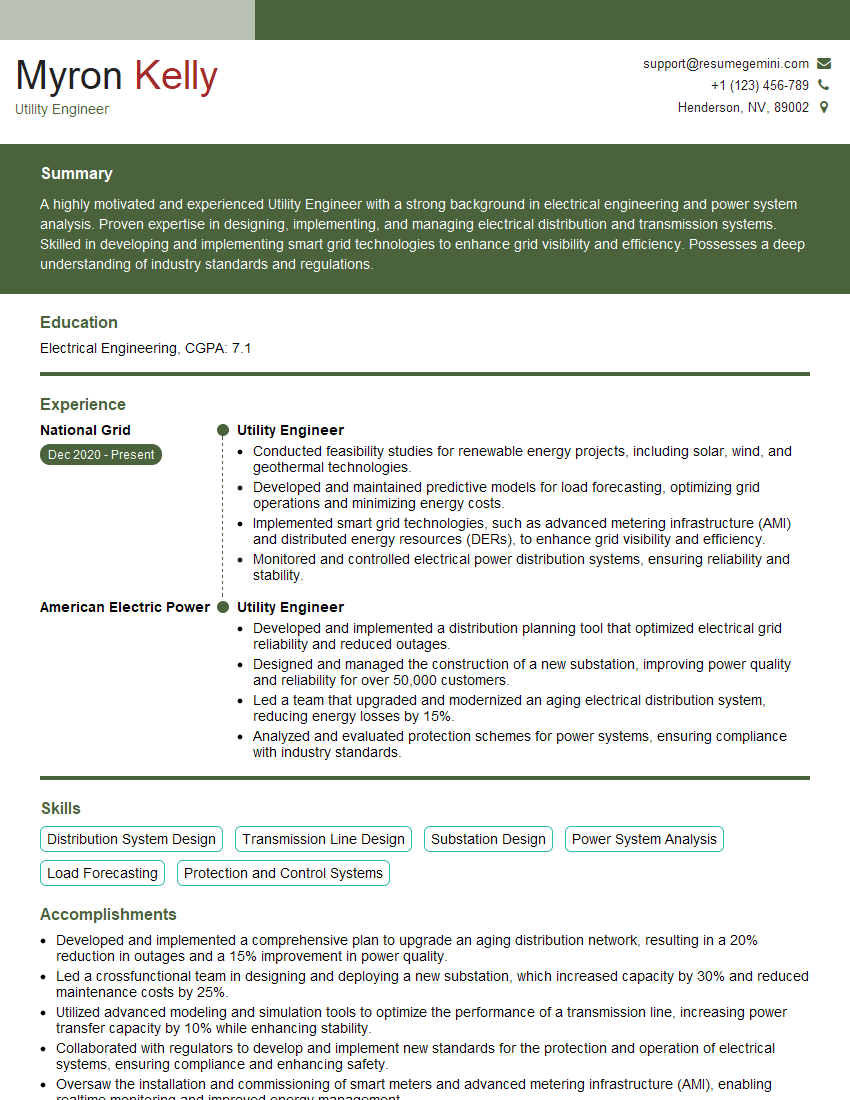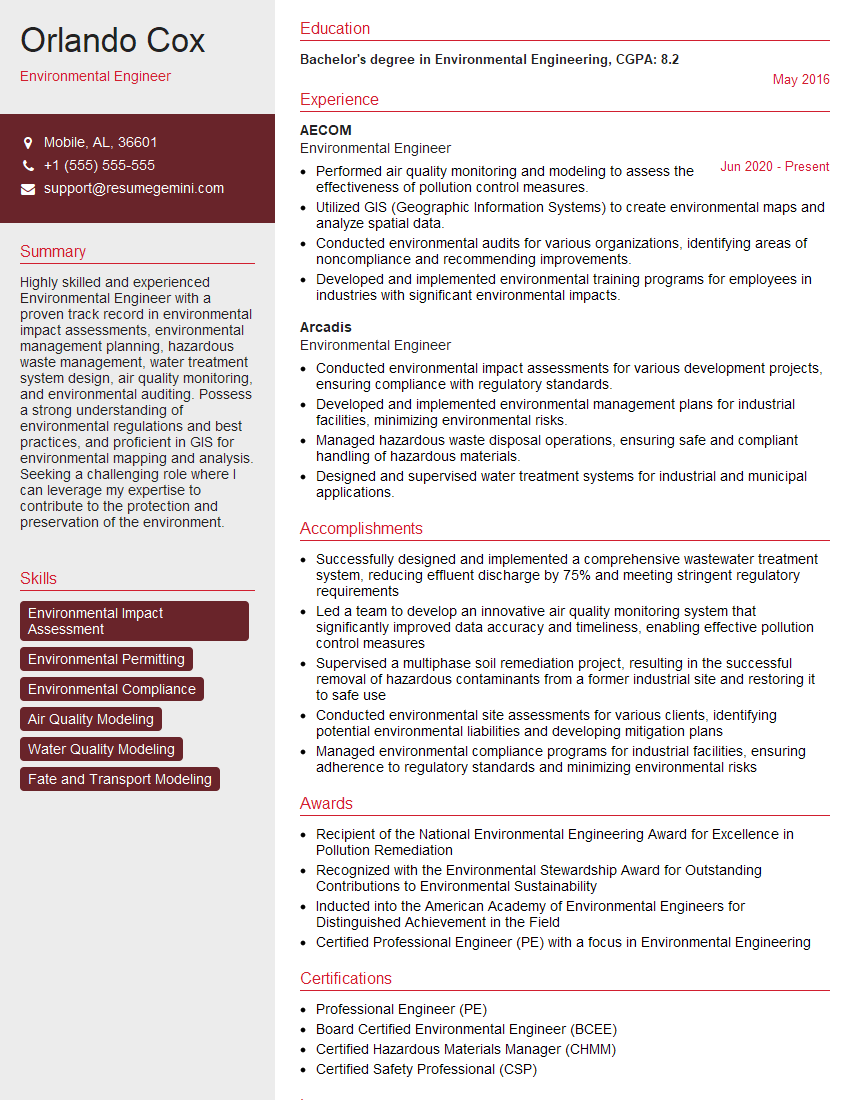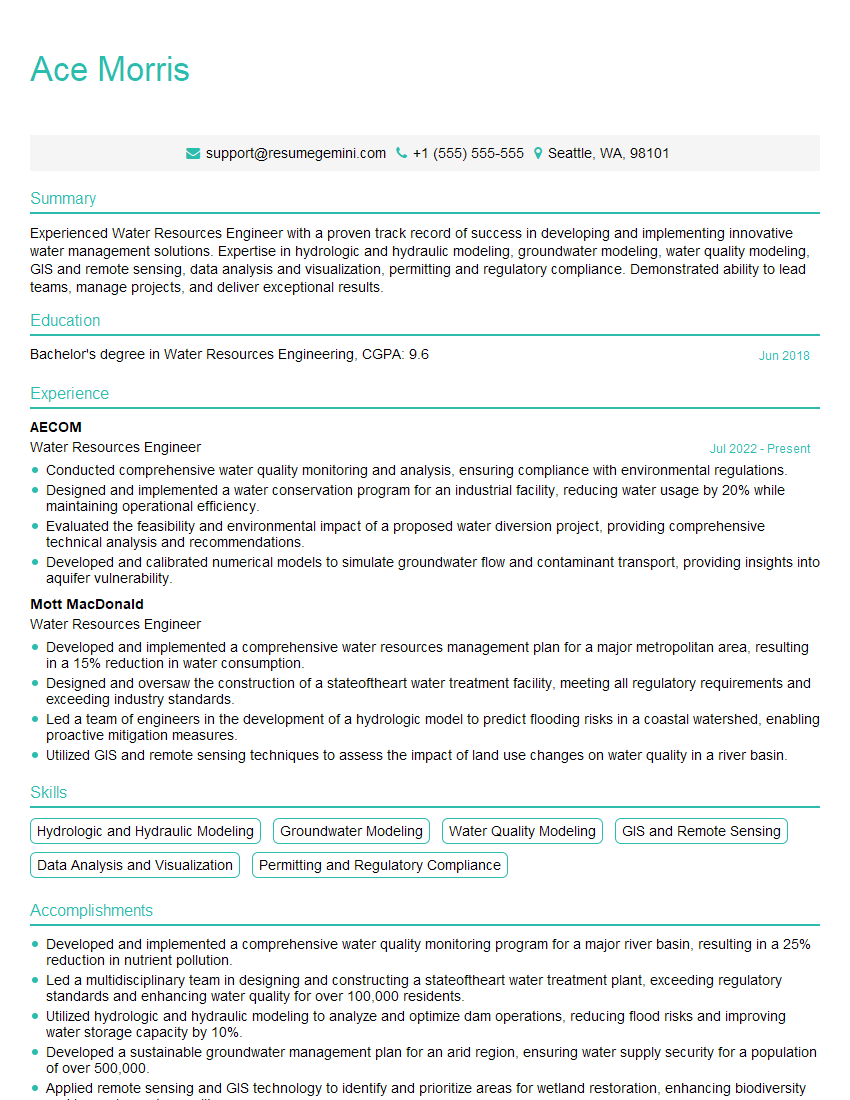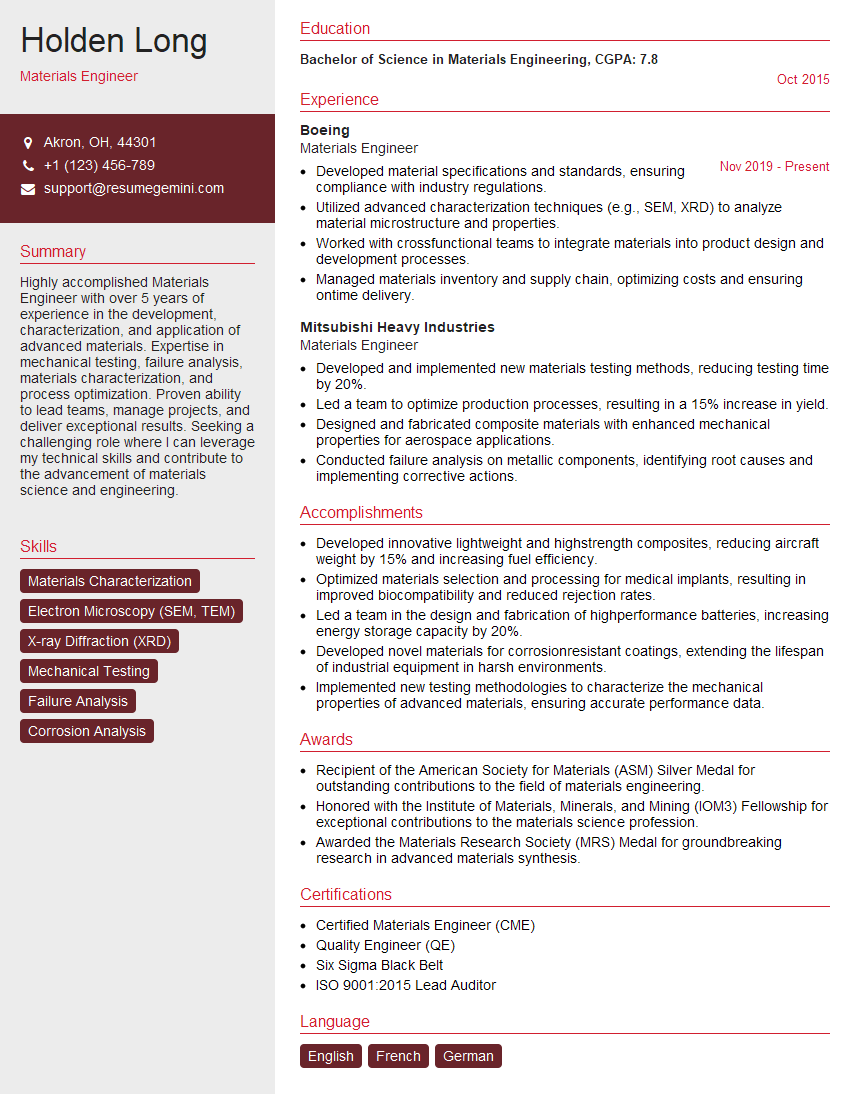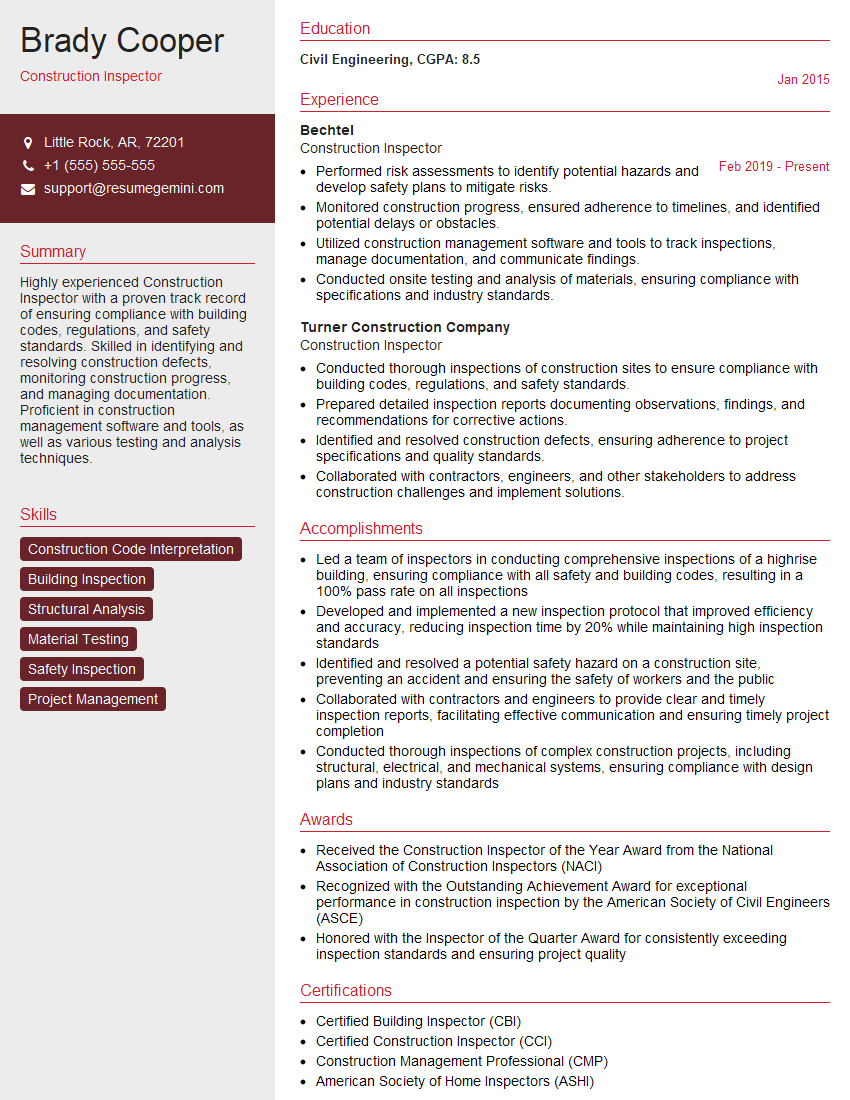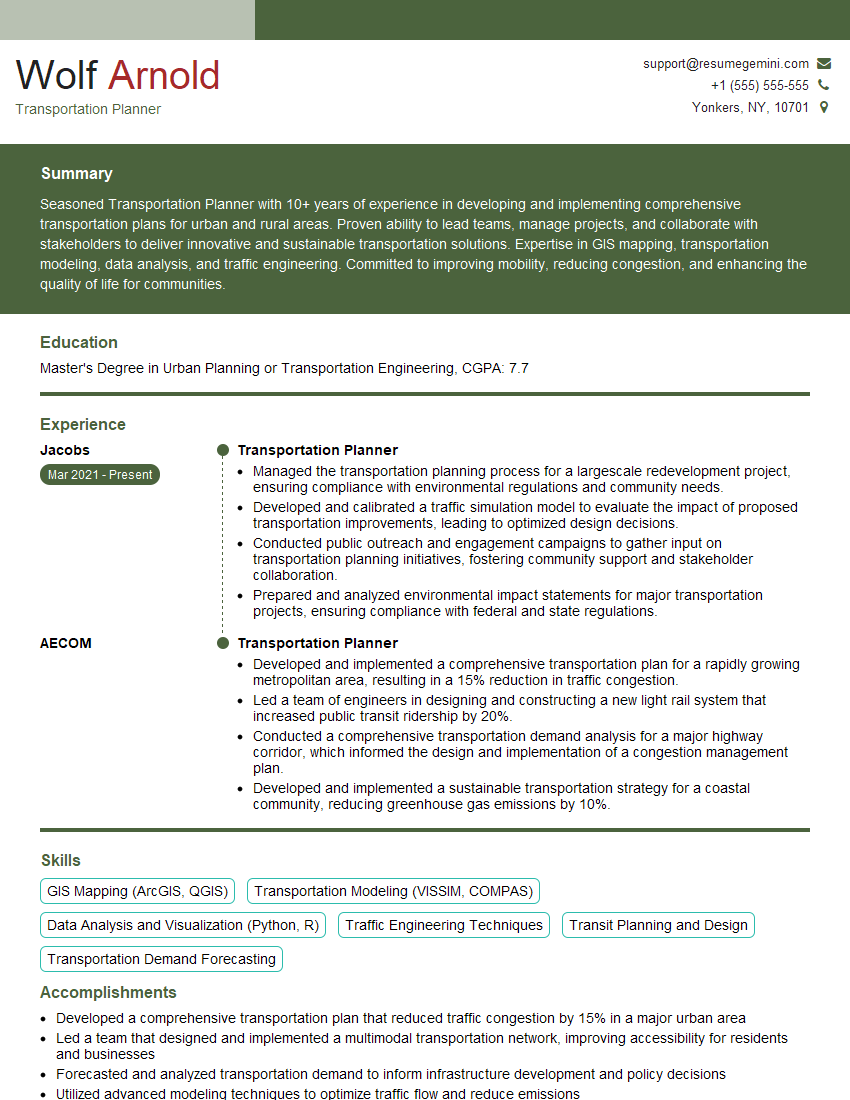Feeling uncertain about what to expect in your upcoming interview? We’ve got you covered! This blog highlights the most important Public Works Projects interview questions and provides actionable advice to help you stand out as the ideal candidate. Let’s pave the way for your success.
Questions Asked in Public Works Projects Interview
Q 1. Describe your experience managing budgets for public works projects.
Managing budgets for public works projects requires meticulous planning, proactive monitoring, and a deep understanding of cost drivers. My approach involves several key steps: First, I develop a comprehensive budget based on detailed cost estimates, encompassing all aspects from materials and labor to permits and contingencies. This often involves utilizing specialized estimating software and collaborating with experienced quantity surveyors. Secondly, I implement a robust cost tracking system, regularly comparing actual expenditures against the budget. This might include using project management software with real-time cost dashboards. Thirdly, I proactively identify and address potential cost overruns. This necessitates regular budget reviews, identifying potential risks, and implementing corrective actions as needed. For instance, on a recent highway widening project, we anticipated potential inflation in material costs, so we secured early contracts with suppliers at fixed prices. Finally, I generate regular financial reports for stakeholders, ensuring transparency and accountability throughout the project lifecycle.
Example: On a recent water pipeline replacement project, initial budgeting indicated a total cost of $5 million. Through proactive cost control measures, including efficient material sourcing and optimized labor deployment, we completed the project under budget, delivering a cost savings of approximately 10%.
Q 2. Explain your process for risk assessment and mitigation in public works projects.
Risk assessment and mitigation are crucial for successful public works projects. My process begins with a thorough identification of potential risks, categorized by their likelihood and potential impact. This involves brainstorming sessions with project team members and relevant stakeholders, considering factors like weather conditions, material availability, regulatory changes, and unforeseen site conditions. Then, I quantify the potential impact of each risk using techniques like probability and impact matrices. Next, I develop mitigation strategies for high-risk items, implementing preventative measures to reduce their likelihood or impact. These could include alternative construction methods, insurance policies, or contingency planning. For example, if a risk is geological instability, I’d include geotechnical investigations and possibly ground improvement measures. Finally, I continuously monitor and review the risks throughout the project, adapting mitigation strategies as needed.
Example: During a bridge construction project, we identified the risk of river flooding as a significant threat. Our mitigation strategy involved incorporating elevated working platforms and establishing clear evacuation procedures to minimize potential delays and safety hazards.
Q 3. How do you ensure compliance with all relevant regulations and permits in public works projects?
Ensuring compliance is paramount in public works. My approach involves proactive engagement with regulatory bodies from the project’s inception. First, I conduct thorough due diligence, identifying all applicable local, state, and federal regulations, including environmental permits, zoning laws, and building codes. Then, I develop a compliance plan which integrates these requirements into each project phase. This involves close collaboration with legal counsel and specialized consultants to ensure all necessary permits and approvals are secured well in advance. We maintain detailed documentation of all approvals and inspections throughout the project to demonstrate compliance. Throughout the project lifecycle, we actively monitor for any regulatory changes and adapt our approach as needed. Regular internal audits are conducted to ensure we maintain adherence to all regulations.
Example: On a recent park renovation project, we worked closely with environmental agencies to obtain permits for wetland mitigation and ensured all construction activities adhered to strict environmental protection standards, resulting in a smooth permitting process.
Q 4. Describe your experience with different types of construction contracts (e.g., lump sum, unit price).
My experience encompasses various construction contract types. Lump sum contracts, where a fixed price is agreed upon for the entire project, are suitable for well-defined projects with minimal design changes. Unit price contracts, where payment is based on the quantity of work completed, are advantageous for projects with variable quantities of work or where the exact scope might not be fully defined upfront. I’ve also worked with cost-plus contracts, which involve reimbursing the contractor for actual costs plus a predetermined fee. These are useful for complex or highly innovative projects, but require rigorous cost control to prevent escalating expenses. I’m familiar with the strengths and weaknesses of each and choose the contract type that best aligns with the project’s complexity, risk profile, and the owner’s risk tolerance.
Example: For a straightforward road resurfacing project, a lump sum contract was ideal. However, for a complex underground utility installation, a unit price contract provided more flexibility to handle unforeseen subsurface conditions.
Q 5. How do you manage stakeholder expectations in complex public works projects?
Managing stakeholder expectations in complex public works projects requires proactive communication and transparency. My strategy begins with clearly defining project goals and objectives at the outset and regularly sharing updates with all stakeholders. This is often facilitated through regular meetings, project reports, and interactive online platforms. I prioritize active listening to understand and address stakeholder concerns and promptly address any issues or misunderstandings. I develop a communication plan which includes specific timelines, methods and responsible parties for all communications. This ensures all stakeholders are kept informed and involved throughout the entire project lifecycle. Building strong relationships with stakeholders, earning their trust through consistent communication and delivering on promises, is key to managing expectations effectively.
Example: On a large-scale transportation project, regular community meetings were conducted to address concerns about traffic disruptions and noise levels, mitigating potential conflicts.
Q 6. What methods do you use to schedule and track progress on public works projects?
Scheduling and progress tracking are essential for successful project delivery. I utilize various methods including critical path method (CPM) scheduling and Gantt charts to visualize project timelines and dependencies. These are often integrated into project management software that allows for real-time tracking and progress updates. Regular progress meetings with the project team are held to review performance against the schedule, identify any potential delays, and implement corrective actions as necessary. Key performance indicators (KPIs) such as percent complete, cost performance index (CPI), and schedule performance index (SPI) are monitored to track progress and identify potential issues early. This allows for proactive intervention and ensures the project stays on track and within budget. Reporting tools help communicate progress to stakeholders accurately and transparently.
Example: Using project management software, we tracked the progress of individual tasks and monitored the critical path, enabling proactive adjustments to maintain the overall project schedule.
Q 7. How do you handle unexpected issues or delays during project execution?
Unexpected issues and delays are inevitable in public works. My approach emphasizes preparedness and a proactive response. Firstly, a robust risk management plan, as mentioned earlier, helps anticipate and mitigate potential problems. When unexpected issues arise, my first step is to thoroughly assess the situation, determining the cause, impact, and potential solutions. This often involves convening a team meeting to brainstorm options and develop a revised plan. We then communicate the issue transparently to stakeholders, managing their expectations realistically. Depending on the nature of the issue, this may involve requesting change orders, negotiating revised timelines, or exploring alternative solutions. Effective documentation is key throughout the process to support any claims or adjustments needed.
Example: During a road construction project, we encountered unforeseen bedrock which was not identified in the initial geotechnical survey. After thoroughly assessing the situation, we implemented a revised plan involving specialized drilling equipment and adjusted the project schedule accordingly, keeping stakeholders informed throughout the process.
Q 8. Describe your experience with quality control and assurance in public works projects.
Quality control (QC) and quality assurance (QA) are crucial for ensuring public works projects meet specifications, are completed safely, and remain within budget. My approach involves a multi-layered system starting with defining clear, measurable quality standards at the outset of a project. This might involve referencing industry best practices, adapting to local regulations, and aligning with the project’s specific goals.
During construction, QC focuses on real-time monitoring. This includes regular inspections to verify that materials meet specifications, workmanship is compliant, and procedures are followed correctly. I often use checklists, photographic documentation, and regular reports to track progress and identify any deviations early. For example, on a recent road resurfacing project, daily inspections ensured the asphalt’s temperature and compaction were within tolerances. Any inconsistencies were addressed immediately, preventing larger issues later.
QA, on the other hand, takes a more holistic view, overseeing the entire QC process. This entails reviewing QC documentation, auditing procedures, and ensuring our systems are effective. We frequently conduct internal audits and may engage external quality control firms for independent verification. A good QA program not only ensures project success but also continuously improves our methods and prevents recurring quality issues. Think of it like preventative maintenance for our project execution. Regular audits help identify weaknesses before they escalate into major problems, saving time, money, and protecting public safety.
Q 9. How do you ensure effective communication among project team members and stakeholders?
Effective communication is the backbone of any successful public works project. My strategy hinges on establishing clear communication channels and employing various methods to reach all stakeholders. This starts with defining roles and responsibilities from the project’s initiation and includes regular project meetings, both formal and informal, to keep everyone informed and aligned.
We utilize a combination of tools such as project management software (e.g., MS Project, Primavera P6) for tracking progress, task assignments, and document sharing. This ensures transparency and readily available information for all team members and stakeholders. Regular email updates, progress reports, and presentations tailored to different audiences ensure that everyone understands the project’s status and their roles. For example, I’ve used simplified infographics to explain complex technical information to community members during public consultation meetings.
Furthermore, open-door policies and informal communication are encouraged to foster a collaborative environment. Addressing concerns and feedback proactively, including promptly responding to queries, keeps everyone engaged and reduces misunderstandings. In essence, we create an ecosystem of transparent communication to avoid silos and ensure that everyone is ‘on the same page’.
Q 10. Explain your approach to conflict resolution in a public works project setting.
Conflict resolution is an inevitable part of large-scale projects. My approach emphasizes proactive conflict management and emphasizes collaboration over confrontation. It begins with fostering a respectful and collaborative work environment where open dialogue is encouraged. This preventative approach often minimizes the need for formal conflict resolution.
When conflicts do arise, I employ a structured approach focusing on active listening, understanding the root causes of the disagreement, and facilitating a discussion among the involved parties. This may involve one-on-one meetings to understand each perspective before bringing everyone together. The goal is not to assign blame, but to identify mutually acceptable solutions.
For instance, a dispute between a contractor and a subcontractor over payment terms was successfully resolved by mediating a discussion, resulting in a compromise that satisfied both parties. In cases where resolution remains elusive, I would involve senior management or even external mediators to facilitate a fair and objective resolution. Documentation of all discussions, agreements, and decisions is critical for transparency and to avoid future recurrences.
Q 11. How do you prioritize competing demands and resource constraints in public works projects?
Prioritizing competing demands and resource constraints requires a strategic and methodical approach. My strategy involves a multi-step process beginning with a clear definition of project objectives and deliverables. This forms the basis for evaluating all competing demands against their contribution to those objectives.
Next, a thorough assessment of available resources – budget, personnel, materials, and time – is undertaken. Then, I use techniques like weighted scoring and constraint analysis to evaluate and prioritize tasks. For instance, a weighted scoring system could assign different weights to factors like project urgency, budget impact, and community impact. This helps objectively determine which tasks should be prioritized, even under pressure.
Resource allocation is then carefully planned to maximize efficiency. We may employ tools like Earned Value Management (EVM) to track progress, manage costs, and identify potential resource shortfalls early. Continuous monitoring and adjustment are key to adapting to unforeseen challenges and ensuring projects stay on track, even with limited resources. Flexibility and decisive decision-making are crucial aspects of this process.
Q 12. Describe your experience with public procurement processes.
I possess extensive experience with public procurement processes, including bidding, tendering, and contract management. My understanding encompasses various procurement methods, from open tendering to negotiated procurement, and I’m familiar with the legal and regulatory frameworks governing public sector procurement. Compliance with ethical guidelines and transparency are paramount in my approach.
The process typically begins with preparing comprehensive tender documents clearly outlining project requirements, specifications, and timelines. This ensures potential bidders have a complete understanding of the project expectations. We use stringent evaluation criteria, often involving a weighted scoring system to objectively assess bids based on factors like price, quality, experience, and adherence to specifications.
Contract management is equally crucial, and I’m skilled in negotiating fair and legally sound contracts, managing contract changes, and resolving disputes effectively. Throughout the procurement process, we maintain meticulous records, adhering to transparency requirements and ensuring fairness and accountability in all decisions. Understanding the nuances of public procurement ensures the project receives high-quality work at a fair price.
Q 13. How familiar are you with different types of pavement materials and their applications?
My knowledge of pavement materials encompasses various types and their specific applications. This includes understanding their properties, performance characteristics, and suitability for different traffic loads and environmental conditions. For example, asphalt concrete is widely used for its flexibility and cost-effectiveness, particularly in high-traffic areas. However, its performance can vary based on the type of binder, aggregate, and mix design.
Portland cement concrete pavements, on the other hand, offer greater durability and longer lifespan, often preferred for heavy-duty applications or in areas with freeze-thaw cycles. Interlocking concrete pavers are another popular choice, especially in pedestrian areas or locations requiring easy repair and replacement. My experience also covers specialized materials like permeable pavements for stormwater management, and recycled materials for sustainable construction.
Choosing the right pavement material involves considering factors like cost, durability, traffic volume, environmental impact, and maintenance requirements. A thorough understanding of these factors ensures the selection of the most appropriate and cost-effective solution for the specific project.
Q 14. What are your experiences with stormwater management systems?
Stormwater management is critical for public works projects, particularly in mitigating flooding and improving water quality. My experience covers various aspects of stormwater management system design, implementation, and maintenance. This includes familiarity with different types of systems, such as detention basins, retention ponds, bioswales, and infiltration systems.
Designing effective stormwater systems requires an understanding of hydrological principles, including runoff estimation and hydraulic modeling. I’ve used software such as HEC-HMS and SWMM to model the flow of water and assess the effectiveness of various stormwater control measures. Implementation includes overseeing the construction of these systems and ensuring they are properly installed and integrated into the overall project design.
Furthermore, my experience extends to post-construction management and maintenance of stormwater systems, ensuring their long-term functionality and environmental effectiveness. Regular inspections, cleaning, and repairs are essential to prevent blockages and ensure that the system continues to perform its intended function, protecting both public infrastructure and the environment.
Q 15. Explain your understanding of sustainable infrastructure practices.
Sustainable infrastructure practices go beyond simply building; they encompass creating structures and systems that meet present needs without compromising the ability of future generations to meet their own. This involves considering environmental, social, and economic factors throughout the entire project lifecycle, from planning and design to construction and operation.
- Environmental Sustainability: This focuses on minimizing the environmental footprint. Examples include using recycled materials, reducing energy consumption through energy-efficient designs, implementing stormwater management systems to reduce runoff, and protecting natural habitats.
- Social Sustainability: This ensures that projects benefit the community and enhance the quality of life. This can involve creating green spaces, improving accessibility, providing job opportunities for local residents, and engaging the community in the planning process.
- Economic Sustainability: This focuses on cost-effectiveness and long-term value. This might include using durable, low-maintenance materials, optimizing project schedules to reduce costs, and considering lifecycle costs, which encompass all costs associated with a project over its entire lifespan.
For example, a sustainable road project might incorporate permeable pavement to reduce runoff and recharge groundwater, use recycled asphalt, and minimize disruption to local businesses and residents during construction. It also needs to be designed to withstand future weather changes to ensure long-term functionality and cost-effectiveness.
Career Expert Tips:
- Ace those interviews! Prepare effectively by reviewing the Top 50 Most Common Interview Questions on ResumeGemini.
- Navigate your job search with confidence! Explore a wide range of Career Tips on ResumeGemini. Learn about common challenges and recommendations to overcome them.
- Craft the perfect resume! Master the Art of Resume Writing with ResumeGemini’s guide. Showcase your unique qualifications and achievements effectively.
- Don’t miss out on holiday savings! Build your dream resume with ResumeGemini’s ATS optimized templates.
Q 16. How do you use technology to improve efficiency and productivity in public works projects?
Technology plays a crucial role in improving efficiency and productivity in public works projects. We leverage various technologies to optimize every stage of a project.
- Building Information Modeling (BIM): BIM uses 3D models to coordinate design, construction, and operation. This helps prevent clashes, optimize designs, and improve collaboration among stakeholders.
- Geographic Information Systems (GIS): GIS allows for visualization and analysis of spatial data, aiding in site selection, utility mapping, and infrastructure planning. It helps assess the impact of projects on the surrounding environment.
- Project Management Software: Tools like Primavera P6 or Microsoft Project facilitate scheduling, cost management, and resource allocation, leading to better project control and reduced delays.
- Drones and Remote Sensing: Drones provide aerial imagery and data for site surveying, progress monitoring, and inspection, significantly reducing time and cost compared to traditional methods.
- Internet of Things (IoT): Sensors embedded in infrastructure can monitor real-time conditions, such as traffic flow, structural health, or water levels, enabling proactive maintenance and improved operational efficiency.
For example, in a bridge construction project, BIM helped us identify potential conflicts between different building systems during the design phase, preventing costly rework during construction. Drones were used to inspect the bridge structure post-completion for any signs of damage, greatly improving inspection safety and efficiency.
Q 17. Describe your experience with different project delivery methods (e.g., design-bid-build, design-build).
I have extensive experience with various project delivery methods, each with its strengths and weaknesses.
- Design-Bid-Build: This traditional method separates design and construction. The owner hires a designer, then contractors bid on the completed design. It’s straightforward but can lead to potential conflicts between designer and contractor, and cost overruns during construction if unforeseen issues arise.
- Design-Build: This method combines design and construction under a single contract. A single entity is responsible for both phases, improving collaboration and potentially reducing costs and schedule delays. However, the owner has less control over the design process.
- Construction Manager at Risk (CMAR): The construction manager acts as an advisor during the design phase and then takes on the risk of constructing the project within a guaranteed maximum price. This approach allows for early contractor involvement and better cost control.
In one project, we utilized Design-Build for a wastewater treatment plant upgrade. The single contractor streamlined the process, leading to a faster completion time and reduced overall cost compared to a traditional Design-Bid-Build approach. For another project, a large highway expansion, CMAR was more effective due to the complexity and the need for a construction manager’s expertise during the design phase.
Q 18. How do you measure the success of a public works project?
Measuring the success of a public works project goes beyond simply completing it on time and within budget. It requires a holistic approach, considering various factors:
- Timeliness: Was the project completed on schedule? Were there any significant delays and if so, what were their causes and were they mitigated effectively?
- Budget: Was the project completed within the allocated budget? Were there any cost overruns, and if so, were they justified?
- Quality: Does the completed infrastructure meet the specified design standards and performance requirements? Are there any defects or issues that require remediation?
- Safety: Were there any accidents or injuries during construction? Was safety given appropriate priority?
- Community Impact: Did the project improve the lives of the community it serves? How was the community involved and consulted throughout the process?
- Environmental Impact: Did the project minimize its environmental impact as planned? Were environmental regulations adhered to?
- Sustainability: Does the completed infrastructure promote long-term sustainability, reducing long-term operating costs and minimizing environmental impact?
We use key performance indicators (KPIs) to track progress and assess performance against these metrics. Regular project reviews and post-project evaluations are essential to identify areas for improvement in future endeavors.
Q 19. What is your experience with environmental impact assessments?
Environmental Impact Assessments (EIAs) are crucial for ensuring that public works projects minimize their environmental impact. My experience includes conducting and reviewing EIAs for various projects, including road construction, bridge replacements, and wastewater treatment plant upgrades.
The process typically involves:
- Identifying potential impacts: This involves assessing the project’s potential effects on air and water quality, noise levels, wildlife habitats, and other environmental factors.
- Developing mitigation measures: Based on the identified impacts, mitigation strategies are developed to minimize or eliminate negative effects. These could include using noise barriers, implementing erosion and sediment control measures, or creating wildlife corridors.
- Documenting findings: A detailed report is prepared summarizing the potential impacts, mitigation measures, and overall environmental consequences of the project.
- Public consultation: Public consultation is essential to involve stakeholders and address their concerns about the project’s environmental impact.
For example, in a highway expansion project, the EIA identified the potential impact on a nearby wetland. Consequently, we implemented mitigation measures such as creating a new wetland area to compensate for the loss and ensuring minimal disruption to the existing ecosystem. The EIA was crucial in securing necessary permits and avoiding potential legal challenges.
Q 20. Describe your experience with Geographic Information Systems (GIS).
Geographic Information Systems (GIS) are indispensable tools in public works. I’ve used GIS extensively for various applications, including:
- Site selection: GIS helps analyze various factors like topography, land use, soil conditions, and proximity to utilities to identify optimal locations for new infrastructure.
- Utility mapping: GIS creates accurate maps of underground utilities, preventing damage during construction and improving safety.
- Infrastructure planning: GIS allows for the visualization and analysis of existing infrastructure networks, helping to identify areas needing improvement or expansion.
- Environmental impact assessment: GIS facilitates the analysis of environmental factors and helps visualize the potential impact of projects on the environment.
- Asset management: GIS helps track and manage infrastructure assets, aiding in scheduling maintenance and repairs.
For example, using GIS to analyze the location of water mains and sewer lines before road construction prevented costly damages to these utilities and significantly reduced project delays. In another instance, GIS was instrumental in identifying suitable locations for new bus stops based on population density, proximity to schools, and accessibility for pedestrians.
Q 21. How do you ensure the safety of workers and the public on public works projects?
Ensuring worker and public safety is paramount in public works projects. A comprehensive safety program is essential, encompassing the following:
- Risk assessment: Identifying and assessing potential hazards is the first step. This includes traffic control, working at heights, handling hazardous materials, and potential exposure to environmental hazards.
- Safety training: Providing adequate training to all workers on safety procedures, hazard recognition, and the use of personal protective equipment (PPE) is crucial.
- Safety protocols: Establishing clear and comprehensive safety protocols, including site-specific safety plans, emergency response procedures, and regular safety inspections, is mandatory.
- Enforcement: Strict enforcement of safety rules and regulations, including regular safety audits, is essential to maintain a safe work environment.
- Public safety measures: Implementing effective measures to protect the public, such as traffic management, barricades, signage, and public communication, is crucial.
For instance, on a bridge construction project, we implemented a comprehensive traffic management plan to minimize disruption to traffic and ensure the safety of both workers and the public. Regular safety meetings and toolbox talks emphasized safe work practices, resulting in a zero-accident record for the project. Utilizing real-time monitoring systems for construction activities and worker presence also reduced safety risks.
Q 22. Explain your understanding of the bidding process for public works contracts.
The bidding process for public works contracts is a competitive system designed to ensure fairness and value for taxpayers. It typically begins with the public entity (city, state, etc.) releasing a Request for Proposals (RFP) or a Request for Bids (RFB), which outlines the project scope, specifications, and requirements. Contractors then submit their bids, detailing their proposed approach, timeline, and cost.
The process often involves multiple stages:
- Pre-qualification: Contractors may need to demonstrate their experience and financial capabilities before being allowed to bid.
- Bid Submission: Contractors submit detailed bids, often including a breakdown of costs, proposed schedule, and qualifications of their team.
- Bid Opening and Evaluation: Bids are publicly opened, and a selection committee evaluates them based on pre-defined criteria, such as price, experience, and proposed methodology. This evaluation may involve scoring systems to compare bids objectively.
- Negotiations (sometimes): In some cases, especially for complex projects, negotiations might occur between the public entity and the highest-ranking bidder to refine the proposal.
- Award: The contract is awarded to the successful bidder, who then enters into a formal agreement with the public entity.
For example, in a road construction project, the RFP might specify the type of asphalt, the required drainage system, and the project completion deadline. Contractors would then submit bids based on these requirements, with the lowest responsible bidder usually selected, although other factors like experience can influence the decision.
Q 23. How familiar are you with different types of utility infrastructure (e.g., water, sewer, gas)?
I possess extensive familiarity with various utility infrastructure systems, including water, sewer, and gas. My understanding extends beyond basic operation to encompass design, construction, maintenance, and the regulatory aspects governing each.
- Water Infrastructure: This includes water treatment plants, distribution networks (pipes, pumps, reservoirs), and the associated metering and monitoring systems. I understand the importance of water quality, pressure management, and leak detection.
- Sewer Infrastructure: My knowledge encompasses sanitary sewer systems (collecting wastewater from homes and businesses), storm sewers (managing stormwater runoff), and wastewater treatment plants. I am familiar with the challenges of managing capacity, preventing overflows, and complying with environmental regulations.
- Gas Infrastructure: This area includes natural gas pipelines, distribution networks, and metering systems. Safety is paramount, and I understand the necessary protocols for handling high-pressure gas lines and preventing leaks.
I’ve worked on projects involving the rehabilitation of aging water mains, the design of new sewer lines for growing communities, and the assessment of gas pipeline integrity. My experience allows me to anticipate potential conflicts between utility lines during construction, ensuring seamless coordination among different utility providers.
Q 24. How do you manage changes to the scope of a public works project?
Managing scope changes in public works projects is crucial for maintaining project integrity and avoiding cost overruns. A formal change management process is necessary, typically involving a documented request, evaluation, approval, and implementation.
The steps usually involve:
- Formal Change Request: A written request, specifying the nature, extent, and justification for the change, is submitted by any stakeholder.
- Impact Assessment: The project team analyzes the impact of the change on the schedule, budget, and overall project goals. This might involve engineering evaluations, cost estimations, and schedule updates.
- Change Order Approval: The change request is reviewed and approved by the relevant authorities, often involving multiple levels of review and sign-offs. This may involve negotiations with the contractor.
- Implementation and Documentation: The approved change is implemented, and all changes are thoroughly documented, including updated drawings, specifications, and the revised budget.
For instance, if unforeseen subsurface conditions are encountered during excavation, a change order might be required to adjust the excavation methods and potentially increase the budget. Proper documentation ensures that all parties understand the changes and their financial implications.
Q 25. What is your experience with public-private partnerships (PPPs)?
I have significant experience working within the framework of Public-Private Partnerships (PPPs). PPPs leverage the expertise and resources of both the public sector and private companies to deliver large-scale infrastructure projects.
My experience includes:
- Project Development: Participating in the initial stages of PPP development, including structuring the project, identifying potential private partners, and negotiating the terms of the contract.
- Risk Allocation: Understanding and managing the risks inherent in PPPs, such as construction delays, cost overruns, and regulatory changes, by assigning responsibility to the appropriate party.
- Contract Negotiation: Negotiating and finalizing the PPP contract, ensuring that the interests of both the public and private sectors are adequately protected.
- Project Monitoring and Oversight: Overseeing the project implementation and ensuring that the project deliverables are met within the agreed timeframe and budget.
One example involved a highway expansion project where a private consortium designed, financed, built, and operated the expanded highway for a set period, after which the ownership transferred back to the public entity. The PPP approach allowed the project to proceed more quickly and efficiently than traditional public procurement methods.
Q 26. Describe your experience with the use of Building Information Modeling (BIM).
Building Information Modeling (BIM) is a crucial tool for modern public works projects. My experience encompasses the full lifecycle of BIM implementation, from initial design to construction and beyond.
My experience includes:
- BIM Design and Modeling: Developing and managing 3D models of infrastructure projects, incorporating detailed information about building components and systems.
- Clash Detection and Coordination: Using BIM software to identify and resolve clashes between different building systems and components before construction begins, preventing costly rework.
- Quantity Takeoff and Cost Estimation: Utilizing BIM to accurately estimate material quantities and project costs.
- 4D and 5D BIM: Integrating scheduling (4D BIM) and cost control (5D BIM) information into the model for enhanced project planning and management.
In a recent bridge rehabilitation project, the use of BIM allowed us to visualize the entire project in 3D, identify potential interferences, and coordinate the work of various subcontractors effectively. The result was a more efficient construction process and fewer delays.
Q 27. How do you ensure that a public works project is completed on time and within budget?
Ensuring timely and budget-conscious completion of public works projects requires a multi-faceted approach, combining proactive planning, robust monitoring, and effective communication.
My strategies include:
- Detailed Project Planning: Developing a comprehensive project plan, including a detailed schedule, resource allocation, and risk assessment. This involves using tools such as critical path analysis (CPA) to identify critical tasks and potential bottlenecks.
- Regular Monitoring and Reporting: Implementing a system for tracking progress against the plan, identifying deviations early, and implementing corrective actions. This often includes regular progress meetings and reports to stakeholders.
- Effective Communication: Maintaining clear and open communication between the project team, contractors, and stakeholders. This ensures that everyone is informed about progress, challenges, and changes.
- Change Management (as discussed earlier): Implementing a robust change management process to control the impact of unforeseen circumstances and modifications.
- Contingency Planning: Developing plans for managing potential risks and uncertainties, including allocating resources for unexpected events.
For example, on a water main replacement project, we implemented a rigorous monitoring system that included daily progress reports and regular inspections. This allowed us to identify and address potential issues promptly, keeping the project on schedule and within budget.
Q 28. What are some common challenges encountered in public works projects, and how have you overcome them?
Public works projects often face numerous challenges. Some common ones include:
- Unexpected Subsurface Conditions: Unforeseen geological conditions or the presence of underground utilities can cause significant delays and cost overruns.
- Permitting and Regulatory Delays: Obtaining necessary permits and approvals can be time-consuming and complex.
- Supply Chain Issues: Delays in the delivery of materials or equipment can disrupt the project schedule.
- Labor Shortages: A shortage of skilled labor can impact project productivity.
- Stakeholder Conflicts: Disagreements or conflicts between different stakeholders (e.g., residents, businesses, agencies) can lead to delays or changes in project scope.
I’ve overcome these challenges by:
- Thorough Site Investigation: Conducting detailed site investigations before construction begins to minimize surprises.
- Proactive Communication: Engaging stakeholders early and often to address concerns and build consensus.
- Risk Management Planning: Developing contingency plans to mitigate potential risks and delays.
- Flexible Project Management: Adapting to changing circumstances and making adjustments to the project plan as needed.
- Strong Contractor Relationships: Fostering strong relationships with contractors and subcontractors to ensure collaboration and efficiency.
For example, when encountering unforeseen rock formations during a road construction project, we employed specialized excavation techniques and adjusted the project schedule accordingly, minimizing the overall impact on the project timeline and budget. Effective communication with the community was crucial in maintaining public support during this unexpected situation.
Key Topics to Learn for Public Works Projects Interview
- Project Planning & Management: Understanding project lifecycles, budgeting, scheduling, and risk management within the context of public works. Practical application: Developing a realistic timeline and budget for a road resurfacing project, considering potential delays and cost overruns.
- Infrastructure Design & Construction: Knowledge of materials, construction methods, and relevant building codes for various infrastructure types (roads, bridges, water systems, etc.). Practical application: Evaluating the suitability of different materials for a bridge construction project based on environmental factors and budget constraints.
- Environmental Impact Assessment & Sustainability: Understanding environmental regulations, sustainable construction practices, and mitigation strategies. Practical application: Analyzing the environmental impact of a proposed highway expansion and suggesting mitigation measures to minimize disruption to local ecosystems.
- Public Procurement & Bidding Processes: Familiarity with government contracting procedures, bid preparation, and contract negotiation. Practical application: Preparing a competitive bid for a public works project, ensuring compliance with all legal and regulatory requirements.
- Community Engagement & Stakeholder Management: Understanding the importance of public consultation, managing stakeholder expectations, and addressing community concerns. Practical application: Developing a communication plan to keep the public informed about the progress of a large-scale construction project.
- Safety & Risk Management: Implementing safety protocols, identifying and mitigating potential hazards on construction sites. Practical application: Developing a comprehensive safety plan for a construction project to minimize workplace accidents and injuries.
- Project Monitoring & Evaluation: Tracking project progress, managing resources effectively, and conducting post-project evaluations. Practical application: Analyzing project performance data to identify areas for improvement and inform future projects.
Next Steps
Mastering Public Works Projects opens doors to a rewarding career with significant societal impact. Advancement opportunities are abundant for skilled professionals who can manage complex projects effectively and contribute to the development of sustainable infrastructure. To significantly boost your job prospects, focus on creating an ATS-friendly resume that highlights your relevant skills and experience. ResumeGemini is a trusted resource to help you build a professional and impactful resume. We provide examples of resumes tailored to Public Works Projects to guide you in creating a winning application. Invest time in crafting a strong resume – it’s your first impression and a crucial step in securing your ideal role.
Explore more articles
Users Rating of Our Blogs
Share Your Experience
We value your feedback! Please rate our content and share your thoughts (optional).
What Readers Say About Our Blog
Hi, I have something for you and recorded a quick Loom video to show the kind of value I can bring to you.
Even if we don’t work together, I’m confident you’ll take away something valuable and learn a few new ideas.
Here’s the link: https://bit.ly/loom-video-daniel
Would love your thoughts after watching!
– Daniel
This was kind of a unique content I found around the specialized skills. Very helpful questions and good detailed answers.
Very Helpful blog, thank you Interviewgemini team.
